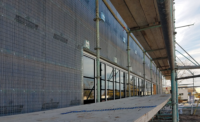Lath Accessories for CI Stucco Claddings
While There May Be Alternative Means to Achieve Closure and Termination, Accessories Developed Specifically for CI Stucco Systems May Provide Simplified Solutions and Detailing.

Table C402.1.3 - Opaque Thermal Envelope Insulation Component Minimum Requirements, R-Value Method.

Figure 1. Drawing courtesy of Plastic Components Inc.

Figure 2. Drawing courtesy of Plastic Components Inc.



The thermal performance of a stucco clad exterior wall assembly has traditionally been achieved by installing insulation in the wall cavity. However, with design trends and energy codes driving the need for more thermally efficient walls, incorporating continuous insulation into the wall assembly may be a necessity depending on the compliance path used to achieve energy efficiency, type of substrate, and climate zone.
For example, compliance with Table C402.1.3 of the 2018 International Energy Conservation Code using the prescriptive R-value method for commercial buildings requires R7.5 CI or higher on above grade, metal framed walls in all but the warmest climate zones across the United States.
Depending on the type and thermal performance of the insulation board, achieving an R 7.5 typically requires an insulation thickness in the range of 1½ to 2 inches.
While it is relatively straightforward to include continuous insulation behind stucco to meet the thermal requirements of a project, doing so increases the thickness of the overall cladding system which moves the external wall plane laterally outwards. This can result in challenging details particularly when the stucco ends or terminates at the top or bottom of a wall, opening, etc. Detailing at such locations should consider and accommodate enclosure of the CI, provide an acceptable appearance, enable integration with other building enclosure elements, and protect the system edge from moisture, fire exposure, and insects.
According to ASTM C 1861 - Standard Specification for Lathing and Furring Accessories, and Fasteners, for Interior and Exterior Portland Cement-Based Plaster, functions of lath accessories include control of the stucco thickness, corner reinforcement, facilitating drainage, crack reduction, separating the stucco from other materials, and providing an edge, end, or termination point for the stucco. Types of lath accessories that accommodate these functions include weep and drainage screeds, cornerbeads, casing beads, expansion joints, and control joints.
Stucco’s Durability
Since stucco is a relatively viscous, hand-applied material, lath accessories have an element referred to as a ground to provide closure and help control the final thickness of the stucco base coat. As the stucco brown coat is applied, a rod or straight edge is used to obtain a true, even plane with the outermost edge of the ground. With respect to stucco thickness, it will differ and vary from approximately 3/8 to 7/8 inch depending upon the type of stucco, design or project requirements and type of plaster base which can be solid, metal or non-metallic. Given these thickness options, lath accessories have generally been available with grounds that ranged from approximately 3/8 inch to just over 1 inch. While these accessories satisfy stucco without a CI component, they may not be a solution for all CI stucco Systems which often approach thicknesses of 3 inch.
Lath accessories for Continuously Insulated (CI) Stucco Claddings serve the same functions as those for traditional 3/8 to 7/8 inch thick stucco. Products, such as control joints, cornerbeads and similar accessories that do not serve an enclosure function, can generally be used with CI stucco since they are simply surface mounted over the CI in lieu of a traditional plaster base. To enclose or encapsulate the CI, some manufacturers market one or more accessories specifically for this purpose.
Generally, enclosure is accomplished by the accessory (Figure 1) or by allowing the stucco to be edge returned perpendicular to the face of the wall (Figure 2). For illustrative purposes, examples of accessories from Plastic Components are shown, however specific products and their configuration depend on the manufacturer.
As with accessories described in ASTM C 1861, CI accessory solutions are typically available in metal as well as plastic which does not rust and is often available in a variety of colors. In general, accessories are available to accommodate CI stucco thicknesses up to approximately 3 inches that is near the practical thickness limitations due to stucco weight and system attachment. Deciding which detail and accessory to use for any given project is largely a function of local practices, aesthetics, cost, performance requirements, and project details/conditions. While there may be alternative means to achieve closure and termination, accessories developed specifically for CI stucco systems may provide simplified solutions and detailing.
Looking for a reprint of this article?
From high-res PDFs to custom plaques, order your copy today!











